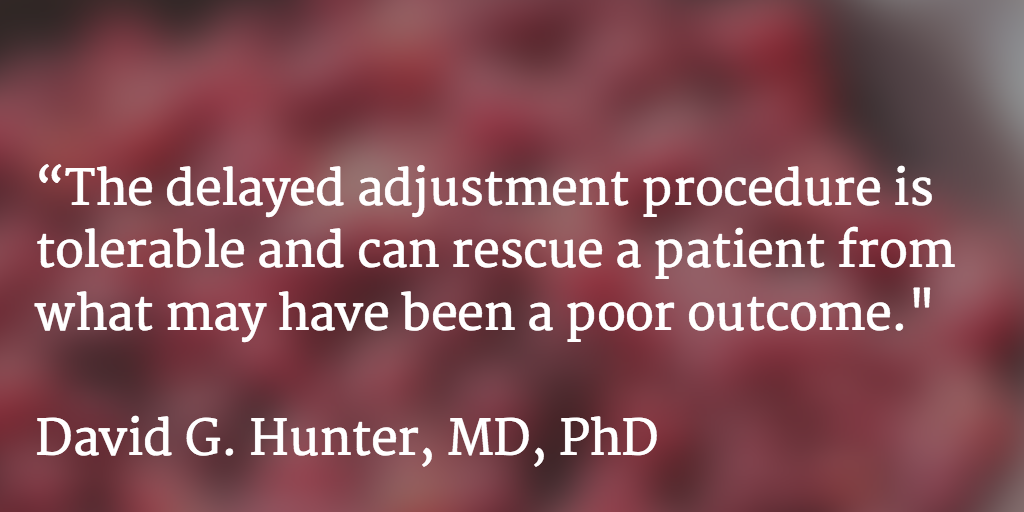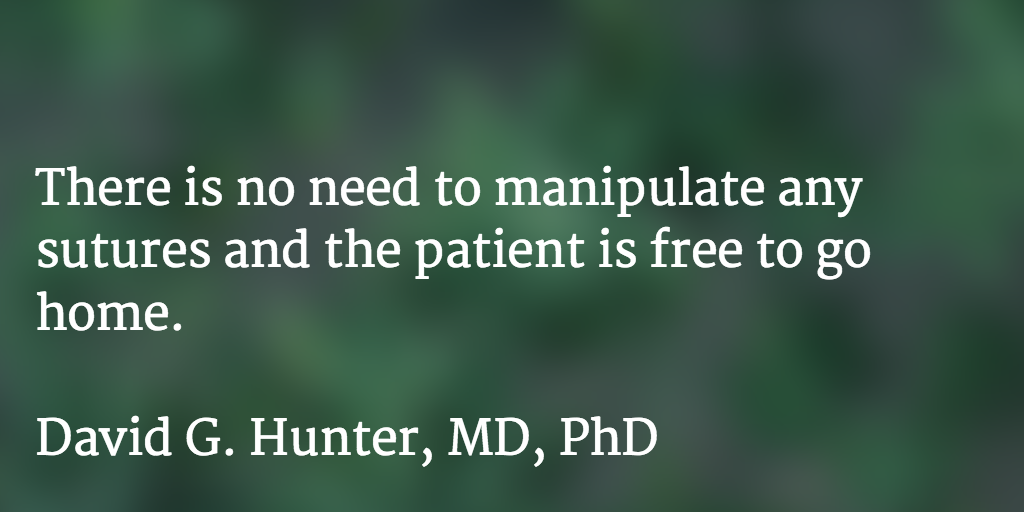Article
Defending adjustable sutures in strabismus surgery
It may be easier than ever for strabismus surgeons to adopt adjustable sutures thanks to a short tag noose adjustable suture technique that allows for optional suture adjustment, according to David G. Hunter, MD, PhD.
While there are no randomized, controlled trials to convince skeptics of the benefits of adjustable sutures in strabismus surgery, most comparative studies show improvements in success rates in the range of 10% to 30%.
Further reading: Femto laser helps acheive 'napkin' capsulotomy
Now, it may be easier than ever for strabismus surgeons to adopt adjustable sutures thanks to a "short tag noose" adjustable suture technique that allows for optional suture adjustment, according to David G. Hunter, MD, PhD.
The adjustment can be delayed for days after the initial strabismus surgery is performed or avoided entirely if the target alignment has been achieved.
“The delayed adjustment procedure is tolerable and can rescue a patient from what may have been a poor outcome,” said Dr. Hunter, who performs an in-office adjustment-if needed-3 to 7 days postoperatively, giving the eye position some time to settle. Many patients require no adjustment at all, and only a small percentage need the delayed adjustment.
The procedure
The short tag noose approach can be performed through a small fornix incision, said Dr. Hunter, ophthalmologist-in-chief at Boston Children’s Hospital and professor and vice chair of ophthalmology at Harvard Medical School.
Once the muscle has been re-attached to the eye with 6-0 Vicryl or an equivalent, the procedure involves five steps:
1. Securing the muscle pole suture ends to each other
2. Placing a sliding noose around the pole sutures at the desired position near their exit from sclera
3. Securing the noose suture ends to each other
4. Trimming the pole and noose sutures to a 5 mm length
5. Tucking the sutures under the conjunctiva
Dr. Hunter explained the approach with a patient undergoing an inferior rectus muscle recession. He makes a 5-mm incision and isolates the inferior rectus muscle on a muscle hook. He passes a Guyton small-incision muscle hook that facilitates maintaining the incision under 5-6 mm, pulling the conjunctiva up and over the ball of the muscle hook.
Next: 'There is no need to manipulate any sutures and the patient is free to go'
“We now have good visualization and can proceed with the surgery without the need to enlarge the incision,” he said.
He explained that the muscle is disinserted after it has been secured, as in most strabismus surgeries, with a central knot followed by locking bites at the muscle poles. These pole sutures are then passed through the center of the original insertion to reattach the muscle to the eye, after which the muscle is pulled up and the sutures tied to each other with an overhand knot.
Next, the sliding slipknot is wrapped around the sutures and then tied tightly and securely using a square knot to hold the muscle in place postoperatively. An overhand knot holds these two ends together about 5 mm from the knot to make it easier to find the sutures in the event adjustment is needed. The sliding noose is then moved up or down the pole sutures to obtain the exact position.
Click for the latest from Ophthalmology Times
In the case under discussion, a 2-mm inferior rectus recession was performed; the position of the sliding noose was confirmed to be 2 mm from the exit site using calipers. Five millimeters of additional pole suture is left beyond the sliding noose to allow for an increase in the recession if an adjustment is needed later. The sutures are tucked under the conjunctiva away from the incision. Because of the small size, the incision often does not need to be closed, he explained.
'The concept of suture adjustment makes sense even to patients'
At the time of suture adjustment-whether on the day of surgery or during an office visit days later-if the alignment is within the target range, there is no need to manipulate any sutures and the patient is free to go home.
If the surgeon wishes to decrease the recession, grasping the pole sutures and then cinching the noose backwards toward the muscle can pull the muscle forward. Conversely, if the desire is to increase the recession, the pole sutures are grasped behind the noose and the noose is pulled the other way. The adjustment can be repeated (or deferred) 3 to 7 days after surgery.
Next: Pearls
Dr. Hunter stated that in rare cases, he has been able to re-adjust after 10 days but he does not generally plan for an adjustment any more than 7 days later, and he prefers to complete the delayed adjustment within 3 to 5 days.
The future of digital lens design
The late adjustment is performed in the office and requires anywhere from 15 to 45 minutes depending on the anxiety level of the patient.
“Most of the time is spent settling patients down and making sure the eye is sufficiently anesthetized,” Dr. Hunter said.
The surgical tray for the procedure includes toothed and smooth forceps, two extra-fine needle holders, a tenotomy hook, and calipers. He uses topical lidocaine, either in drop form or pre-drawn in a syringe topped with a flat (Randolph) cannula.
For particularly anxious patients he prescribes 1 mm Ativan to be taken before arrival for the assessment, and then administers another milligram after he confirms the decision to adjust following the examination. Some patients may benefit from oxycodone. Patients also take 400 to 800 mm of ibuprofen for the anticipated headache following the adjustment.
Some pearls
“I call patients at home a day or two after surgery to see how they are doing,” Dr. Hunter says. “That way, I have a pretty good idea about whether they are going to need an adjustment, or whether they need to come into the office at all.”
Don’t make the sutures too short, he said, and if the pole or noose sutures are much less than 5 mm, it can be more difficult to get them to stay tucked under conjunctiva.
Retrieving the suture for the adjustment is usually straightforward, but sometimes it can be the longest part of the procedure. Keeping the pole and the noose ends together when tucking them under conjunctiva makes it easier to retrieve both.
Next: 'The concept of suture adjustment makes sense even to patients'
Check to determine whether the muscle is adhering to the globe. When it is, the pole suture will not slide forward easily and it may require additional anesthesia to allow passage of a hook under the muscle attachment site to separate it from the globe. Dr. Hunter confirms that the muscle is free by observing the forward movement of the noose when he pulls on the pole sutures.
Over time, it can become more difficult to move the sliding noose.
“After a few days, the sliding movement is not always as smooth as it would have been an hour after placement-it may jump in 1-2 mm increments,” he noted.
After completing the adjustment, he steadies the eye with forceps and then asks the patient to look in the direction of the muscle, which pulls it into position.
After the adjustment, the alignment is checked. If required, the process can be repeated; usually the second or third adjustment in a session is easier to perform because the patient knows what to expect.
Once the desired alignment is achieved, tucking the sutures back under the conjunctiva concludes the adjustment. It takes about 2 months for the sutures to disappear, and more like 4-6 months for the last vestiges of redness to fade.
The disadvantages of the procedure are the longer operating time (by about 5 minutes), increased suture material after the procedure, increased patient anxiety about the impending adjustment, a chance of changes in alignment despite the suture adjustment, and a risk of oculocardiac reflex during adjustment.
“As I have performed more suture adjustments, I have learned that if I move slowly, talk to the patient, and pause immediately if a patient describes feeling warm or queasy, I can avoid a vagal reaction,” Dr. Hunter said.
The biggest disadvantage is the logistics of scheduling the suture adjustment, but the short tag noose gives a lot more flexibility in scheduling than traditional adjustable sutures, he explained.
“The procedure is not necessarily pleasant for patients but it is certainly tolerable, and the concept of suture adjustment makes sense even to patients who are anxious about the procedure,” Dr. Hunter said. “While I don’t need to adjust every patient, or even half the patients, having the ability to perform a suture adjustment-only when needed, and days after surgery in some cases-has transformed the way I approach every case.”
Newsletter
Don’t miss out—get Ophthalmology Times updates on the latest clinical advancements and expert interviews, straight to your inbox.






